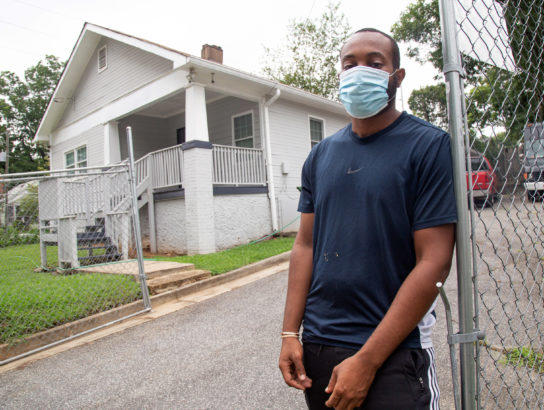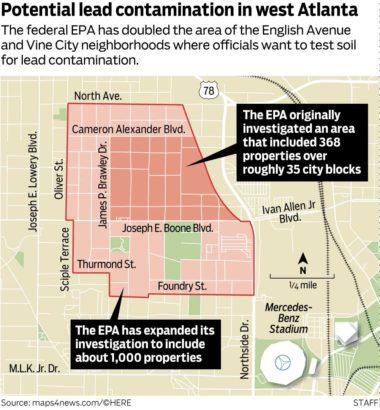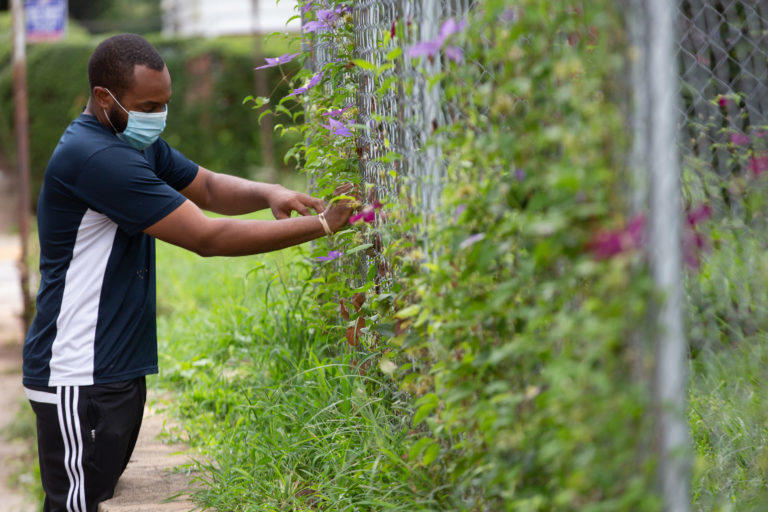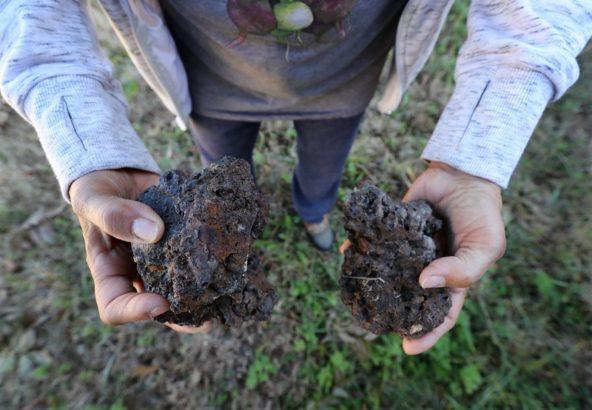
Caption
The yard of Terboris Barnes contains a substantial amount of lead, but Barnes recently learned EPA plans to do nothing for his property. / AJC
Credit: Steve Schaefer

The yard of Terboris Barnes contains a substantial amount of lead, but Barnes recently learned EPA plans to do nothing for his property. / AJC
The federal Environmental Protection Agency has removed lead-contaminated soil from more than 30 properties in west Atlanta as part of a major cleanup of the area.
But there is early evidence that some contaminated properties won’t get the same treatment.
The yard of Terboris Barnes contains a substantial amount of lead, but Barnes recently learned EPA plans to do nothing for his property because the lead level recorded was just under the threshold for remediation.

The federal Environmental Protection Agency has removed lead-contaminated soil from more than 30 properties in west Atlanta as part of a major cleanup of the area. But there is early evidence that some contaminated properties won’t get the same treatment. The yard of Terboris Barnes contains a substantial amount of lead, but Barnes recently learned EPA plans to do nothing for his property because the lead level recorded was just under the threshold for remediation.
The EPA’s investigation of the low-income English Avenue area was launched after an Emory University team discovered high levels of lead — a potent neurotoxin especially dangerous for children — in the soil there.
So far, the EPA has found 148 properties with lead levels of 400 parts per million, the agency’s threshold for removal of soil.
Testing of Barnes’ property on James P. Brawley Drive found a level of 394 parts per million — just short of the removal mark.
An Oct. 1 letter from the agency told Barnes, 29, that he qualified for a soil removal. But later that month, a second letter from EPA said his property did not qualify.
“The number was so close,’’ Barnes said. “They said they would not retest.‘’
He said he wants the agency to excavate the soil, or at least check its lead levels again.
A University of Georgia soil expert said that the 400 parts per million threshold was probably set for budget reasons.
Jay Lessl, program coordinator for the Soil, Plant, and Water Laboratory at UGA, said 75 parts per million is the point when lead levels are considered elevated enough to be a concern, though a smaller risk.
“While the EPA acknowledges that there is risk at that level, they set a higher level before requiring some type of remediation’’ at 400 parts per million, Lessl said. “This is likely due to the pervasive problem of soil lead contamination in urban areas. If they set a lower level, it would likely be prohibitively expensive due to the large areas that require action.’’
EPA spokeswoman Allison Wise said the 400 parts per million cleanup level was based on site-specific data and the scientific based model that is used by all of EPA’s U.S. regions.
“Reducing childhood lead exposure is a top priority for the Trump administration,” she said.
Lead is a naturally occurring element. But there is no safe level of lead exposure for children, the Atlanta-based Centers for Disease Control and Prevention says.
Children can absorb as much as 90% more lead into their bodies than do adults. Researchers have found that even at low levels, lead can damage a child’s brain, lowering intelligence and damaging the ability to control their behavior and attention. At higher levels, lead can affect growth, and it can replace iron in the blood, leading to anemia and fatigue.
In adults, lead poisoning can cause an increased risk of high blood pressure and damage the nerves and kidneys. It also can cause miscarriages.

Teboris Barnes tends to flowers along the fence line in his West Atlanta yard. / Georgia Health News
English Avenue and Vine City are historic African-American neighborhoods and among the city’s poorest.
The EPA has been testing soil in this area since last year. The original investigation area of 368 properties, covering roughly 35 city blocks, was expanded earlier this year to include about 1,000 properties in the English Avenue/Vine City district.

Pollution dates to earlier era English Avenue and Vine City are historic African-American neighborhoods and among the city’s poorest. The EPA has been testing soil in this area since last year. The original investigation area of 368 properties, covering roughly 35 city blocks, was expanded earlier this year to include about 1,000 properties in the English Avenue/Vine City district. / Georgia Health News
So far, out of 351 properties tested, more than 40% have shown contamination above 400 parts per million.
Lead contamination in soil can be the residue of smelters and other industrial processes but also a product of lead paint and vehicle exhaust from the era of leaded gasoline.
On Atlanta’s westside, Emory and EPA researchers speculate that homes were built on top of slag, a byproduct of smelting, that was brought in and used to fill in low-lying areas.
Eri Saikawa, the Emory professor who led the student team in 2018, said she believes the current boundary of the EPA testing zone “is quite subjective.”
“It’s not scientifically based,‘’ she said.
She said she plans to offer a lead testing program for people to bring samples of their soil for analysis.
Last year, The Atlanta Journal-Constitution and the Georgia News Lab found historical evidence of lead poisoning in children in the Elm Street ZIP code, where Rosario Hernandez lives, and in the ZIP code next to it, in Georgia Department of Public Health data.
The front yards of Hernandez’s two homes now have fresh sod, while the back yards are covered with wood chips. Hernandez said the EPA, after stripping away her raised garden beds, has filled them in again with new soil.
Though there have been some delays, the EPA has followed through at her home and other re-sodded properties nearby, Hernandez said.
“People seem happy,” she said.
The EPA estimates it has spent about $250,000 on sampling and assessment. For the soil removal and remediation, the total budget is $5.9 million, of which EPA has spent about $3 million.
Several houses in the area are boarded up alongside streets with uneven, pocked pavement. Other homes have flowers and gardens.
Barnes himself works in his yard, and planted the clematis that’s climbing up the chain link fence in front of his home.
He said he heard about the lead contamination from news reports. “I definitely knew about lead and that exposure to it is not good,” he said.
He bought the property two years ago. He said he would have negotiated a better price if he had known about the lead contamination.
Paying for an excavation himself could cost him thousands of dollars, Barnes said. “I believe I deserve an excavation of my yard.’’
This story comes to GPB through a partnership with Georgia Health News.
The Fund for Investigative Journalism and the Democracy Fund have provided support for this reporting.